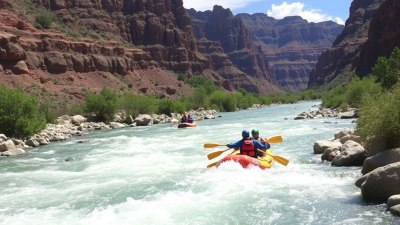Places You Can Watch Wildlife Without a Safari Tour
Discover the best locations to observe wildlife without the need for a safari tour.

Image by gpointstudio on Freepik
When we think of wildlife observation, our minds often drift to safari tours in exotic locations. However, venturing out into nature to observe wildlife doesn't necessarily require a grand expedition. There are numerous locations worldwide where you can experience wildlife in their natural habitat without the costs or commitments associated with traditional safari tours. These alternatives offer unique opportunities for wildlife enthusiasts, whether you’re a birdwatcher, a mammal lover, or someone keen on experiencing marine life. In this article, we will explore some of the best places you can visit to enjoy wildlife watching at its best, diving into distinctive habitats that showcase nature's diversity.
1. National Parks in the United States
The United States boasts a plethora of national parks, many of which serve as sanctuaries for wildlife. Yellowstone National Park is perhaps one of the most iconic. It is home to bison, elk, wolves, and bears. With over 3,400 square miles of protected land, visitors can witness stunning wildlife scenes throughout the year. Other notable parks include Grand Teton National Park, known for its moose and migratory birds, and Yosemite National Park, where you can find black bears amidst majestic sequoias. Wildlife viewing is often most fruitful during dawn and dusk when animals are more active.
2. Canada’s Parks and Preserves
Canada is home to diverse ecosystems and vast landscapes teeming with wildlife. Banff National Park and Jasper National Park in the Canadian Rockies offer breathtaking vistas and abundant wildlife, including bears, mountain goats, and elk. The Bay of Fundy is a fantastic location for whale watching, particularly for humpback, minke, and the endangered North Atlantic right whale. Newfoundland’s Gros Morne National Park also provides opportunities to see caribou in their natural habitat. Wildlife viewing in Canada often involves stunning backdrops of mountains and coastal scenery.
3. Alaska’s Wildlife Refuges
Alaska is a haven for wildlife lovers. The Kenai Fjords National Park provides visitors a chance to see sea otters, seals, and a variety of birds against a backdrop of stunning glaciers. In Denali National Park, adventurers can spot grizzly bears, moose, and Dall sheep easily along the scenic roads. The Arctic National Wildlife Refuge, located in the northeastern part of the state, allows for unique wildlife observation opportunities with species such as polar bears and migratory birds. For those interested in marine life, the Inside Passage cruise routes also offer ideal spots for watching whales and other marine mammals.
4. Breathtaking Locations in Central and South America
For an adventure in exotic biodiversity, look no further than Central and South America. Costa Rica is one of the top destinations for observing a wide variety of wildlife, from colorful toucans to sloths and howler monkeys. The Monteverde Cloud Forest Reserve offers guided nocturnal tours, giving you a chance to see creatures such as frogs and insects that come alive at night. Meanwhile, the Amazon Rainforest is a biodiversity hotspot where you can find jaguars, macaws, and capybaras along with countless species of plants and insects. In Brazil, the Pantanal, one of the world’s largest tropical wetlands, is renowned for its jaguar population, making it an excellent place to observe these magnificent big cats in their natural habitat.
5. Wildlife Viewing in Australian Outback
Australia offers some of the most unique wildlife experiences on the planet. The Outback is the place to see kangaroos, emus, and various reptiles in their natural environments. You can visit areas like Kakadu National Park, where saltwater crocs dwell, or explore the remote areas of Uluru-Kata Tjuta National Park, where the red rock formations provide a stunning backdrop for wildlife viewing. Moreover, Australia's diverse marine life can be seen through snorkeling or diving at the Great Barrier Reef, where colorful fish and majestic sea turtles abound.
6. European Wildlife Watching
7. Islands of the World
Islands often host unique biodiversity due to their isolated ecosystems, making them prime locations for wildlife watching. The Galápagos Islands are renowned for their endemic species, such as the giant tortoise and blue-footed booby. Visiting these islands offers you an intimate experience with wildlife, as many species are unafraid of human presence. On the other hand, Madagascar presents a rich array of wildlife, including various lemurs, chameleons, and unique flora found nowhere else on Earth. The volcanic landscapes and dense rainforests provide ideal settings for those eager to explore nature’s wonders.
8. Urban Wildlife Observation
Believe it or not, you don’t have to leave the cities to experience wildlife. Many urban areas offer amazing opportunities to see wildlife. For example, Central Park in New York City attracts over 250 species of birds, making it a birdwatcher's paradise, especially during migration seasons. San Francisco's Golden Gate Park offers glimpses of raccoons, deer, and various bird species. Even cities like London and Sydney foster urban wildlife, where animals have adapted to the city environment. Visiting local parks, green spaces, and botanical gardens can yield surprising insights into how wildlife thrives even amidst urbanity.
9. Ecotourism Destinations
Ecotourism is a growing trend that promotes responsible travel to natural areas that conserves the environment and improves the well-being of local people. Many ecotourism destinations focus on wildlife watching opportunities without the need for traditional safari tours. Locations like Borneo allow you to explore rainforests while witnessing orangutans and pygmy elephants in their natural habitats. In Tanzania, you might opt for a walking tour alongside knowledgeable guides who can share insights into the local flora and fauna. These experiences can enhance your appreciation for nature while contributing positively to the ecosystems and communities you’re visiting.
10. Best Practices for Wildlife Watching
While the thrill of watching wildlife excites many outdoor enthusiasts, it is crucial to approach wildlife observation responsibly. Respect wildlife by maintaining a safe distance, minimizing noise, and avoiding feeding animals. Educate yourself about the behaviors of wildlife to enhance your tracking and spotting skills. Whenever possible, use binoculars or zoom lenses for a better viewing experience. This allows you to appreciate the beauty of the animals without intruding on their space. Always follow local guidelines and regulations regarding wildlife observation to preserve these precious habitats for future generations.
In conclusion, exploring wildlife doesn’t have to involve embarkation on expensive safari tours. With an array of destinations around the world—from national parks in the USA to the breathtaking landscapes of Australia, or even the urban parks in the heart of cities—you can experience the beauty of wildlife all year round. Each of these locations offers unique opportunities to observe animals in their natural habitats, enriching your travel experience while connecting you to the beauty of nature. Whether you’re birdwatching in a city park or hiking through a national forest, you will discover that the thrill of wildlife observation is accessible and rewarding for everyone.











